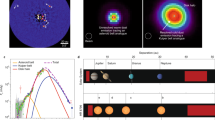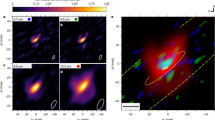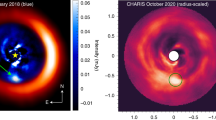Abstract
Planetary debris disks around other stars are analogous to the asteroid and Kuiper belts in the Solar System. Their structure reveals the configuration of small bodies and provides hints for the presence of planets. The nearby star Fomalhaut hosts one of the most prominent debris disks, resolved by the Hubble Space Telescope, Spitzer, Herschel and the Atacama Large Millimeter Array. Images of this system at mid-infrared wavelengths using JWST/MIRI not only show the narrow Kuiper belt-analogue outer ring, but also that (1) what was thought from indirect evidence to be an asteroid-analogue structure is instead broad, extending outward into the outer system, and (2) there is an intermediate belt, probably shepherded by an unseen planet. The newly discovered belt is demarcated by an inner gap, located at ~78 au, and it is misaligned relative to the outer belt. The previously known collisionally generated dust cloud, Fomalhaut b, could have originated from this belt, suggesting increased dynamical stirring and collision rates there. We also discovered a large dust cloud within the outer ring, possible evidence of another dust-creating collision. Taken together with previous observations, Fomalhaut appears to be the site of a complex and possibly dynamically active planetary system.
This is a preview of subscription content, access via your institution
Access options
Access Nature and 54 other Nature Portfolio journals
Get Nature+, our best-value online-access subscription
$29.99 / 30 days
cancel any time
Subscribe to this journal
Receive 12 digital issues and online access to articles
$119.00 per year
only $9.92 per issue
Buy this article
- Purchase on Springer Link
- Instant access to full article PDF
Prices may be subject to local taxes which are calculated during checkout





Similar content being viewed by others
Data availability
The final reduced and processed JWST MIRI imaging data that we present in this paper (and others including geometric distortion corrections) can be downloaded from https://github.com/merope82/Fomalhaut. The raw and general pipeline processed data products will be available from the Mikulski Archive for Space Telescopes at the Space Telescope Science Institute following their public release. The JWST observations are associated with programme 1193, while the HST observations are associated with programme 15905.
References
Aumann, H. H. et al. Discovery of a shell around Alpha Lyrae. Astrophys. J. Lett. 278, L23–L27 (1984).
Gillett, F. C. IRAS observations of cool excess around main sequence stars. In Light on Dark Matter (ed. Israel, F. P.) 61–69 (Astrophysics and Space Science Library Vol. 124, Springer, 1986).
van Leeuwen, F. Validation of the new Hipparcos reduction. Astron. Astrophys. 474, 653–664 (2007).
MacGregor, M. A. et al. A complete ALMA map of the Fomalhaut debris disk. Astrophys. J. 842, 8 (2017).
Rhee, J. H., Song, I., Zuckerman, B. & McElwain, M. Characterization of dusty debris disks: the IRAS and Hipparcos catalogs. Astrophys. J. 660, 1556–1571 (2007).
Kalas, P., Graham, J. R. & Clampin, M. A planetary system as the origin of structure in Fomalhaut’s dust belt. Nature 435, 1067–1070 (2005).
Galicher, R., Marois, C., Zuckerman, B. & Macintosh, B. Fomalhaut b: independent analysis of the Hubble Space Telescope public archive data. Astrophys. J. 769, 42 (2013).
Gáspár, A. & Rieke, G. New HST data and modeling reveal a massive planetesimal collision around Fomalhaut. Proc. Natl Acad. Sci. USA 117, 9712–9722 (2020).
Stapelfeldt, K. R. et al. First look at the Fomalhaut debris disk with the Spitzer Space Telescope. Astrophys. J. Suppl. Ser. 154, 458–462 (2004).
Acke, B. et al. Herschel images of Fomalhaut. An extrasolar Kuiper belt at the height of its dynamical activity. Astron. Astrophys. 540, A125 (2012).
Holland, W. S. et al. Submillimetre images of dusty debris around nearby stars. Nature 392, 788–791 (1998).
Holland, W. S. et al. Submillimeter observations of an asymmetric dust disk around Fomalhaut. Astrophys. J. 582, 1141–1146 (2003).
Boley, A. C. et al. Constraining the planetary system of Fomalhaut using high-resolution ALMA observations. Astrophys. J. Lett. 750, L21 (2012).
White, S. M. et al. Observing the Sun with the Atacama Large Millimeter/Submillimeter Array (ALMA): fast-scan single-dish mapping. Sol. Phys. 292, 88 (2017).
Espinoza, P., Su, K., Rieke, G. & Stapelfeldt, K. Discovery of an extended halo in the Fomalhaut debris system. Am. Astron. Soc. Meet. Abstr. 217, 339.01 (2011).
Lebreton, J. et al. An interferometric study of the Fomalhaut inner debris disk. III. Detailed models of the exozodiacal disk and its origin. Astron. Astrophys. 555, A146 (2013).
Su, K. Y. L. et al. Asteroid belts in debris disk twins: Vega and Fomalhaut. Astrophys. J. 763, 118 (2013).
Adams, J. D., Herter, T. L., Lau, R. M., Trinh, C. & Hankins, M. Dust production rates in the Fomalhaut debris disk from SOFIA/FORCAST mid-infrared imaging. Astrophys. J. 862, 161 (2018).
Absil, O. et al. An interferometric study of the Fomalhaut inner debris disk. I. Near-infrared detection of hot dust with VLTI/VINCI. Astrophys. J. 704, 150–160 (2009).
Mennesson, B. et al. An interferometric study of the Fomalhaut inner debris disk. II. Keck Nuller mid-infrared observations. Astrophys. J. 763, 119 (2013).
Roman, N. G. Planets of other suns. Astron. J. 64, 344–345 (1959).
Quillen, A. C. Predictions for a planet just inside Fomalhaut’s eccentric ring. Mon. Not. R. Astron. Soc. 372, L14–L18 (2006).
Chiang, E., Kite, E., Kalas, P., Graham, J. R. & Clampin, M. Fomalhaut’s debris disk and planet: constraining the mass of Fomalhaut b from disk morphology. Astrophys. J. 693, 734–749 (2009).
Kalas, P. et al. Optical images of an exosolar planet 25 light-years from Earth. Science 322, 1345–1348 (2008).
Lawler, S. M., Greenstreet, S. & Gladman, B. Fomalhaut b as a dust cloud: frequent collisions within the Fomalhaut disk. Astrophys. J. Lett. 802, L20 (2015).
Morales, F. Y. et al. Common warm dust temperatures around main-sequence stars. Astrophys. J. Lett. 730, L29 (2011).
Su, K. Y. L. & Rieke, G. H. Signposts of multiple planets in debris disks. Proc. Int. Astron. Union 8, 318–321 (2013).
Ballering, N. P., Rieke, G. H. & Gáspár, A. Probing the terrestrial regions of planetary systems: warm debris disks with emission features. Astrophys. J. 793, 57 (2014).
Kennedy, G. M. & Wyatt, M. C. Do two-temperature debris discs have multiple belts? Mon. Not. R. Astron. Soc. 444, 3164–3182 (2014).
Ballering, N. P., Rieke, G. H., Su, K. Y. L. & Gáspár, A. What sets the radial locations of warm debris disks? Astrophys. J. 845, 120 (2017).
Geiler, F. & Krivov, A. V. Does warm debris dust stem from asteroid belts? Mon. Not. R. Astron. Soc. 468, 959–970 (2017).
Boccaletti, A. et al. JWST/MIRI coronagraphic performances as measured on-sky. Astron. Astrophys. 667, A165 (2022).
Esposito, T. M. et al. Debris disk results from the Gemini Planet Imager Exoplanet Survey’s polarimetric imaging campaign. Astron. J. 160, 24 (2020).
Wolff, S. G., Gáspár, A., H. Rieke, G., Ballering, N. & Ygouf, M. Hiding dust around ϵ Eridani. Astron. J. 165, 115 (2023).
Su, K. Y. L. et al. The inner debris structure in the Fomalhaut planetary system. Astrophys. J. 818, 45 (2016).
Gauchet, L. et al. Sparse aperture masking at the VLT. II. Detection limits for the eight debris disks stars β Pic, AU Mic, 49 Cet, η Tel, Fomalhaut, g Lup, HD 181327 and HR 8799. Astron. Astrophys. 595, A31 (2016).
Maire, A. L. et al. Search for cool giant exoplanets around young and nearby stars. VLT/NaCo near-infrared phase-coronagraphic and differential imaging. Astron. Astrophys. 566, A126 (2014).
Kenworthy, M. A. et al. Coronagraphic observations of Fomalhaut at Solar System scales. Astrophys. J. 764, 7 (2013).
Gáspár, A., Psaltis, D., Özel, F., Rieke, G. H. & Cooney, A. Modeling collisional cascades in debris disks: the numerical method. Astrophys. J. 749, 14 (2012).
Marois, C. et al. Direct imaging of multiple planets orbiting the star HR 8799. Science 322, 1348–1352 (2008).
Janson, M. et al. Infrared non-detection of Fomalhaut b: implications for the planet interpretation. Astrophys. J. 747, 116 (2012).
Kennedy, G. M. & Wyatt, M. C. Collisional evolution of irregular satellite swarms: detectable dust around Solar System and extrasolar planets. Mon. Not. R. Astron. Soc. 412, 2137–2153 (2011).
Kenyon, S. J. & Bromley, B. C. Collisional cascade calculations for irregular satellite swarms in Fomalhaut b. Astrophys. J. 811, 60 (2015).
Kenyon, S. J., Currie, T. & Bromley, B. C. Fomalhaut b as a cloud of dust: testing aspects of planet formation theory. Astrophys. J. 786, 70 (2014).
MacGregor, M. A. et al. Millimeter emission structure in the first ALMA image of the AU Mic debris disk. Astrophys. J. Lett. 762, L21 (2013).
Ricci, L. et al. ALMA observations of the debris disk around the young solar analog HD 107146. Astrophys. J. 798, 124 (2015).
Faramaz, V. et al. A detailed characterization of HR 8799’s debris disk with ALMA in band 7. Astron. J. 161, 271 (2021).
Draine, B. T. & Lee, H. M. Optical properties of interstellar graphite and silicate grains. Astrophys. J. 285, 89–108 (1984).
Wright et al. (in the press).
Rieke, M. J. et al. Performance of NIRCam on JWST in flight. Publ. Astron. Soc. Pac. 135, 028001 (2023).
Ressler, M. E. et al. Performance of the JWST/MIRI Si:As detectors. Proc. SPIE 7021, 70210O (2008).
Bouchet, P. et al. The Mid-Infrared Instrument for the James Webb Space Telescope, III: MIRIM, the MIRI imager. Publ. Astron. Soc. Pac. 127, 612 (2015).
Perrin, M. D. et al. Updated point spread function simulations for JWST with WebbPSF. Proc. SPIE 9143, 91433X (2014).
Acknowledgements
We acknowledge the assistance of our programme coordinators, C. Mannfolk and B. Porterfield, especially in ensuring a quick repeat of the initially failed PSF reference observations. We thank M. Perrin and M. Lallo for updating us on the primary mirror alignment while we waited for the repeat of the PSF observations. Financial support for this work was provided by grants 80NSSC22K1293 and HST-GO-15905.001-A to the University of Arizona and also grant 80NM0018D0004 to the Jet Propulsion Laboratory, California Institute of Technology. This work is based in part on observations made with the NASA/ESA/CSA JW and HST. The data were obtained from the Mikulski Archive for Space Telescopes at the Space Telescope Science Institute, which is operated by the Association of Universities for Research in Astronomy, Inc., under NASA contract NAS 5-03127 for JWST.
Author information
Authors and Affiliations
Contributions
The observations were designed by A.G. and G.H.R. and the data were reduced and processed by A.G. and S.G.W., while all coauthors contributed to the data analysis and writing of the manuscript.
Corresponding author
Ethics declarations
Competing interests
The authors declare no competing interests.
Peer review
Peer review information
Nature Astronomy thanks Brenda Matthews and the other, anonymous, reviewer(s) for their contribution to the peer review of this work.
Additional information
Publisher’s note Springer Nature remains neutral with regard to jurisdictional claims in published maps and institutional affiliations.
Supplementary information
Supplementary Information
Supplementary Discussion, Tables 1–3 and Figs. 1–12.
Rights and permissions
Springer Nature or its licensor (e.g. a society or other partner) holds exclusive rights to this article under a publishing agreement with the author(s) or other rightsholder(s); author self-archiving of the accepted manuscript version of this article is solely governed by the terms of such publishing agreement and applicable law.
About this article
Cite this article
Gáspár, A., Wolff, S.G., Rieke, G.H. et al. Spatially resolved imaging of the inner Fomalhaut disk using JWST/MIRI. Nat Astron 7, 790–798 (2023). https://doi.org/10.1038/s41550-023-01962-6
Received:
Accepted:
Published:
Issue Date:
DOI: https://doi.org/10.1038/s41550-023-01962-6



